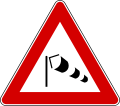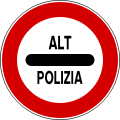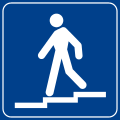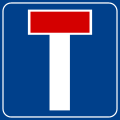Road signs in Italy

Road signs in Italy conform to the general pattern of those used in most other European countries. They are regulated by the Codice della Strada (Highway Code) and by the Regolamento di Attuazione del Codice della Strada in conformity with the Vienna Convention on Road Signs and Signals.
Design
Distances and other measurements are displayed in metric units.
Warning signs are usually placed 150 metres before the area they're referring to; if they're farther or nearer, an additional sign displays the actual distance in metres. Prohibition signs and mandatory instruction signs, instead, are placed exactly at the beginning of the area of validity.
Colours and shapes
Signs follow the general European conventions concerning the use of shape and colour to indicate function of signs:
| Type of sign | Shape | Border | Background colour |
|---|---|---|---|
| Warning | Triangular | Red | White |
| Prohibition | Circular | Red | White |
| Mandatory instructions | Circular | White | Blue |
| Supplementary | Rectangular | Black | White |
| Information | Rectangular | White | White (urban) Blue (other roads) Green (motorway) |
Colours of directional road signs
- On motorways, directional signs are green with white lettering.
- On main roads, directional signs with more than one destination are blue with white lettering.
- Within cities, directional signs with more than one destination are white with black lettering.
On main roads and within cities, the colour of a directional sign with a single destination depends on the type of destination:
- if the destination is a city that is reached by means of a motorway, the sign is green and carries the motorway name as well as the destination
- in the other cases when the destination is a city, the sign is blue
- if the destination is a city district, a hospital or an airport, the sign is white
- if the destination is a tourist attraction, the sign is brown
Typeface

A version of the Transport typeface employed on road signs in the UK, called Alfabeto Normale, is used on Italian road signs. A condensed version, called Alfabeto Stretto, is also used for long names that wouldn't fit. Each name uses one font, but names in Alfabeto Normale and in Alfabeto Stretto can co-exist on one sign.
The font is officially regulated by the 1992 Codice della Strada, article 39 section 125.[1] It defines both Alfabeto Normale and Alfabeto Stretto for uppercase letters, lowercase letters and digits, "positive" (dark on light background) and "negative" (light on dark background). However, there are regulations about the use of Alfabeto Normale dating back to 1969.[2]
Uppercase is used in most cases. Lowercase is sometimes used for city districts and tourist attractions.
Language
The standard language is Italian. In some autonomous regions or provinces bilingual signs are used (mainly Italian/German in South Tyrol, Italian/French in Aosta Valley and Italian/Slovenian along the Slovenian border, but also Italian/Friulan in the Friuli historical region and Italian/Sardinian in Sardinia).
Gallery
Warning signs
-
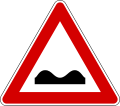
Uneven road
(formerly used )
) -
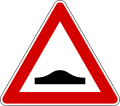
Humps
-

Dip
-

Bend, to right
(formerly used )
) -

Bend, to left
(formerly used )
) -

Double bend, first to right
(formerly used )
) -
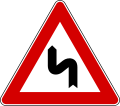
Double bend, first to left
(formerly used )
) -

Level crossing with barrier or gate ahead
(formerly used )
) -

Level crossing without barrier or gate ahead
(formerly used )
) -

Single Level crossing
(formerly used )
) -

Multiple level crossing
(formerly used )
) -

Trams crossing ahead
-

Pedestrian crossing
(formerly used )
) -

Steep hill downwards
(formerly used )
) -

Steep hill upwards
-

Road narrows
(formerly used )
) -

Road narrows on right
-

Road narrows on left
-

Opening or swing bridge ahead
-
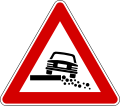
Dangerous verges
-

Slippery road
(formerly used )
) -

Children
(formerly used )
) -

Cattle
(formerly used )
) -
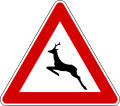
Wild animals
(formerly used )
) -

Two-way traffic
(formerly used )
) -

Roundabout ahead
-

Loose chippings
-
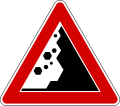
Falling rocks
-

Traffic lights
(formerly used )
) -

Low-flying aircraft
-

Risk of fire
(formerly used )
) -

Other danger
(formerly used )
)
Temporary signs
-
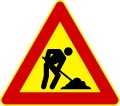
Road works
(formerly used )
) -

Uneven road
-

Road narrows
-

Road narrows on right
-

Road narrows on left
-

Loose chippings
-

Other danger
Regulatory signs
-

Give Way
(formerly used )
) -

Stop and give way
(formerly used )
) -

Crossroads with right-of-way from the right
(formerly used )
) -

Give priority to vehicles from opposite direction
(formerly used )
) -

Priority road
(formerly used )
) -

End of priority road
(formerly used )
) -

Crossroads
(formerly used )
) -
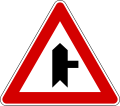
Junction with a minor side-road from right
-

Junction with a minor side-road from left
-

Merging traffic from right
(formerly used )
) -

Merging traffic from left
(formerly used )
) -

Traffic has priority over oncoming vehicles
(formerly used )
) -

Restricted vehicular access
(formerly used )
) -

No entry for vehicular traffic
(formerly used )
) -

No overtaking
(formerly used )
) -
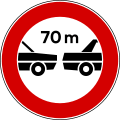
Minimum distance
-

Maximum speed 50 km/h
(formerly used )
) -

No use of horns
(formerly used )
) -

No animal-drawn vehicles
(formerly used )
) -
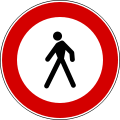
No pedestrians
(formerly used )
) -

No bicycles
(formerly used )
) -
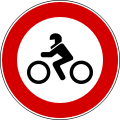
No motorcycles
(formerly used.svg.png) )
) -
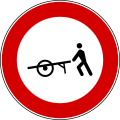
No handcarts
(formerly used )
) -

No motor vehicles
(formerly used )
) -

No buses
(formerly used )
) -

No large goods vehicles
(formerly used )
) -
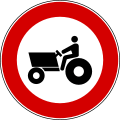
No tractors
-
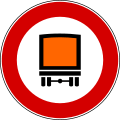
No vehicles carrying dangerous goods
-

No vehicles carrying explosives or flammable goods
-
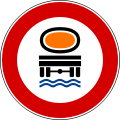
No vehicles carrying goods which could pollute water
-

No vehicles over width shown
(formerly used )
) -

No vehicles over height shown
(formerly used )
) -
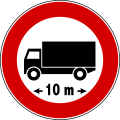
No vehicles over length shown
-

Maximum weight in tonnes
(formerly used )
) -

Derestriction
-
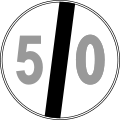
End of maximum speed
(formerly used )
) -

End of no overtaking
(formerly used )
) -

End of no overtaking by heavy goods vehicles
-

No parking
(formerly used )
) -

No stopping
(formerly used )
) -

Parking place
(formerly used )
) -

Drive straight
-

Turn right
(formerly used )
) -

Turn left
-

Turn right ahead
-

Turn left ahead
-
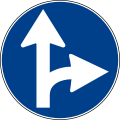
Drive straight or turn right
(formerly used or
or  )
) -

Drive straight or turn left
(formerly used )
) -
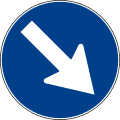
Keep right
-

Keep left
-
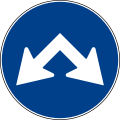
Pass either side
-

Roundabout
(formerly used )
) -

Minimum speed
(formerly used )
) -

End of minimum speed
-
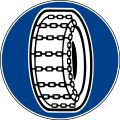
Snow chains compulsory
(formerly used )
) -

Customs
(formerly used )
) -
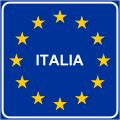
EU Country border
-

Stop, pay toll
-
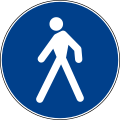
Pedestrian lane
(formerly used )
) -

Cycle lane
(formerly used )
) -

End of cycle lane
-

End of shared path
-
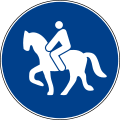
Bridleway
(formerly used )
) -

End of bridleway
Indication signs
-

Motorway direction
-

Primary or secondary road direction
-

Urban area direction
-

Direction to tourist attraction
-

Directions in urban areas
-

Directions in urban areas. The green panel indicates a motorway
-

Directions on a main highway
(formerly used )
) -

Directions on a main highway
-

Directions on a motorway
-

Motorway number sign
-

Motorway spur number sign
-

International tunnel number sign
-

Main road number sign
(formerly used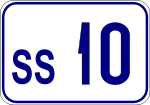 )
) -

Main road number sign
-

Main road number sign
(formerly used )
) -

Minor road number sign
(formerly used )
) -

European road number sign
(formerly used )
) -

Distance to a motorway service area
-

Distance sign on a main highway
-

Town name sign
-

Village name sign
-

End of residential area, with distances to other towns
-

Provincial boundary sign (main road)
-

Provincial boundary sign (motorway)
-

Regional boundary sign (main road)
-

Regional boundary sign (motorway)
-

Street name sign
-

Street name sign with one way
-

Town boundary name sign
-

River sign
-

Directions to tourist destinations
-

Direction to an industrial zone
-

Directions in an industrial area
-

Hospital
(formerly used )
) -

School bus
(formerly used )
) -

Pedestrian ramp
-

Advisory speed limit
-

End of advisory speed limit
-

Fast-traffic highway, only motor vehicles allowed
(formerly used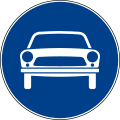 and
and .svg.png) )
) -
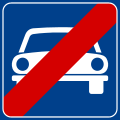
End of road reserved for motor vehicles
-
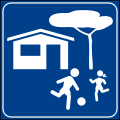
Home Zone Entry
-
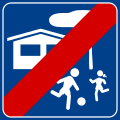
End of Home Zone
-

Motorway-like dual carriageway
-
.svg.png)
One-way traffic (right)
(formerly used.svg.png) )
) -
.svg.png)
One-way traffic (left)
(formerly used.svg.png) )
) -

Repairs
-

Telephone
(formerly used )
) -

Petrol station with LPG
-

Tram stop
-

Information centre
-

Picnic site
-

Local radio information
-

Refreshments
-

Motorail services
-

Car ferries
-

Distance to a motorway service area
Obsolete signs
-
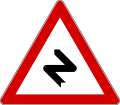
Dangerous bends
-

Give way to the line coaches
-

No U-turn
-

No right turn
-

No left turn
-

No overtaking for trucks
-

End of no overtaking for trucks
-

Alternative parking
-
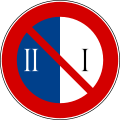
Alternative parking
-

Motor vehicle lane
-
.svg.png)
Motorcycle lane
-

Two lanes traffic
References
External links
| Wikimedia Commons has media related to Road signs in Italy. |

